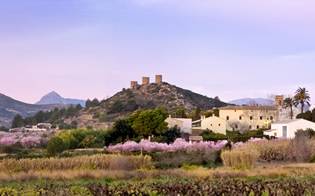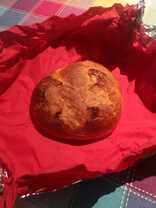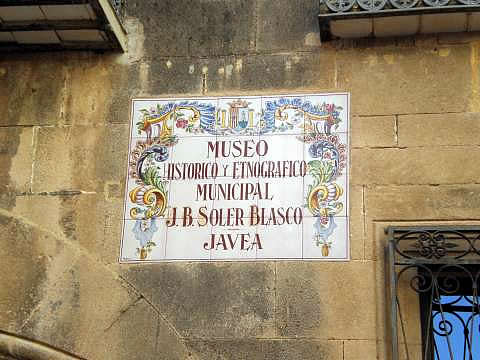
Most of the windmills in the Valencian region were built in the Marina Alta. There have been windmills in our region since medieval times, possibly even during the Andalusian period. The largest concentration of windmills is in the area around Montgó, Xàbia, with 12 mills, Gata with 3, Pedreguer with 2 and Dénia, with 5.
The three mills of Jesús Pobre, a district of Dénia (now designated with the curious name of an EATIM: (entidad de ámbito territorial inferior al municipio - Territorial entity inferior to the municipality) are on the top of a small hill, 155 metres high, one kilometre south-west of the village. The three mills were in operation in the second half of the 18th century, which is when they were probably built. They maintain the characteristics of other mills in the Marina Alta. Two floors, with a single entrance door (open to the south-west), an upper floor supported by a rough tosca stone vault, (where the millstones and machinery were located) ventilated and illuminated by two opposing windows. Access to the grinding wheel room was via a staircase with stone steps attached to the inside wall of the building. There were also four sails and a mobile conical roof. Time and neglect have led to the disappearance of many of these elements, leaving only the robust cylindrical structure of masonry, built with irregular limestone blocks and lime mortar. AMUX visited these windmills on April 17th
0 Comments
 ... a centuries-old tradition in the Valencian and Catalan regions? It is possible that the name harks back to the Arabic word „muna“ in the 15th century, a provision or gift, that was paid in kind as a land tax. Here in Xabia, until not long ago, it was made in each household during the Easter Week. The ladies would knead and knead the dough until it had the right consistency and then it would be laid to rest under a multitude of covers and blankets in the matrimonial bed - for many hours, so that the fermented dough would double in size. Once ready, the monas would be taken to one of the 5 or 6 large ovens that were in Javea, since the oven at home was too small to hold all the monas. The tradition is that this was always gifted - hence the name - by the godparents or the grandparents to the children. In Xabia, they always gave the children a pair of „zapatillas“ as well, flat rubber-soled shoes used for sports, that were usually bought at the La Rulla shoe shop. Easter was celebrated for at least 3 days (Sunday, Monday and Tuesday ). Family and friends would celebrate it by spending the morning in their „ casita de campo“ and in the evening all would go to the beach for a picnic with the monas. They would carry these in a small basket that the grandparents gave them. These were handcrafted baskets made at home from esparto grass or palm leaves. At the beach the children would play games, hop with skipping ropes, toss spinning tops and light fireworks. I remember that the most beautiful mona was always taken as a present to a family in mourning for the recent loss of a family member ( for it was frowned upon to make monas while in mourning). A gesture of solidarity towards family and friends ! Happy Easter to all! |
ACTIVITIES
Categories |
- Home
- Blogs
-
Projectes
- Premio de Investigación - Formularios de Inscripción
-
Traducciones Translations
>
-
DISPLAY PANELS - GROUND FLOOR
>
- THE STONE AGES - PALAEOLITHIC, EPIPALAEOLITHIC AND NEOLITHIC
- CAVE PAINTINGS (ARTE RUPESTRE)
- CHALCOLITHIC (Copper) & BRONZE AGES
- THE IBERIAN CULTURE (THE IRON AGE)
- THE IBERIAN TREASURE OF XÀBIA
- THE ROMAN SETTLEMENTS OF XÀBIA
- THE ROMAN SITE AT PUNTA DE L'ARENAL
- THE MUNTANYAR NECROPOLIS
- ARCHITECTURAL DECORATIONS OF THE PUNTA DE L'ARENAL
- THE ATZÚBIA SITE
- THE MINYANA SMITHY
- Translations archive
- Quaderns: Versión castellana >
- Quaderns: English versions >
-
DISPLAY PANELS - GROUND FLOOR
>
- Catálogo de castillos regionales >
- Exposició - Castells Andalusins >
- Exposición - Castillos Andalusíes >
- Exhibition - Islamic castles >
- Sylvia A. Schofield - Libros donados
- Mejorar la entrada/improve the entrance >
-
Historia y enlaces
-
Historía de Xàbia
>
- Els papers de l'arxiu, Xàbia / los papeles del archivo
- La Cova del Barranc del Migdia
- El Vell Cementeri de Xàbia
- El Torpedinament del Vapor Germanine
- El Saladar i les Salines
- La Telegrafía y la Casa de Cable
- Pescadores de Xàbia
- La Caseta de Biot
- Castell de la Granadella
- La Guerra Civil / the Spanish civil war >
- History of Xàbia (English articles) >
- Charlas y excursiones / talks and excursions >
- Investigacions del museu - Museum investigations
- Enllaços
- Enlaces
- Links
-
Historía de Xàbia
>
- Social media
- Visitas virtuales
- Tenda Tienda Shop


 RSS Feed
RSS Feed
